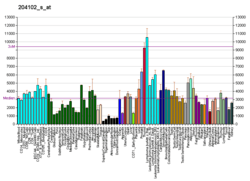EEF2
Eukaryotic elongation factor 2 is a protein that in humans is encoded by the EEF2 gene.[5][6][7]
This gene encodes a member of the GTP-binding translation elongation factor family. This protein is an essential factor for protein synthesis. It promotes the GTP-dependent translocation of the ribosome. This protein is completely inactivated by EF-2 kinase phosphorylation.[7]
It is the target of diphtheria toxin (from Corynebacterium diphtheriae), and exotoxin A (from Pseudomonas aeruginosa).[8] The inactivation of EF-2 by toxins inhibits protein production in the host, causing symptoms due to loss of function in affected cells.
References
- 1 2 3 GRCh38: Ensembl release 89: ENSG00000167658 - Ensembl, May 2017
- 1 2 3 GRCm38: Ensembl release 89: ENSMUSG00000034994 - Ensembl, May 2017
- ↑ "Human PubMed Reference:".
- ↑ "Mouse PubMed Reference:".
- ↑ Rapp G, Klaudiny J, Hagendorff G, Luck MR, Scheit KH (Mar 1990). "Complete sequence of the coding region of human elongation factor 2 (EF-2) by enzymatic amplification of cDNA from human ovarian granulosa cells". Biol Chem Hoppe-Seyler. 370 (10): 1071–5. doi:10.1515/bchm3.1989.370.2.1071. PMID 2610926.
- ↑ Kaneda Y, Yoshida MC, Kohno K, Uchida T, Okada Y (Jul 1984). "Chromosomal assignment of the gene for human elongation factor 2". Proc Natl Acad Sci U S A. 81 (10): 3158–62. doi:10.1073/pnas.81.10.3158. PMC 345240. PMID 6427766.
- 1 2 "Entrez Gene: EEF2 eukaryotic translation elongation factor 2".
- ↑ Jørgensen R, Merrill AR, Andersen GR (February 2006). "The life and death of translation elongation factor 2". Biochem. Soc. Trans. 34 (Pt 1): 1–6. doi:10.1042/BST20060001. PMID 16246167.
Further reading
- Hanes J, Freudenstein J, Rapp G, Scheit KH (1992). "Construction of a plasmid containing the complete coding region of human elongation factor 2". Biol. Chem. Hoppe-Seyler. 373 (4): 201–4. doi:10.1515/bchm3.1992.373.1.201. PMID 1596361.
- Nygård O, Nilsson L (1990). "Kinetic determination of the effects of ADP-ribosylation on the interaction of eukaryotic elongation factor 2 with ribosomes". J. Biol. Chem. 265 (11): 6030–4. PMID 2318846.
- Rapp G, Mucha J, Einspanier R, et al. (1988). "Cloning and sequence analysis of a cDNA from human ovarian granulosa cells encoding the C-terminal part of human elongation factor 2". Biol. Chem. Hoppe-Seyler. 369 (4): 247–50. doi:10.1515/bchm3.1988.369.1.247. PMID 2840927.
- Kaneda Y, Hayes H, Uchida T, et al. (1987). "Regional assignment of five genes on human chromosome 19". Chromosoma. 95 (1): 8–12. doi:10.1007/BF00293835. PMID 3034518.
- Nairn AC, Palfrey HC (1988). "Identification of the major Mr 100,000 substrate for calmodulin-dependent protein kinase III in mammalian cells as elongation factor-2". J. Biol. Chem. 262 (36): 17299–303. PMID 3693353.
- Shestakova EA, Motuz LP, Minin AA, Gavrilova LP (1993). "Study of localization of the protein-synthesizing machinery along actin filament bundles". Cell Biol. Int. 17 (4): 409–16. doi:10.1006/cbir.1993.1079. PMID 8318952.
- Redpath NT, Price NT, Severinov KV, Proud CG (1993). "Regulation of elongation factor-2 by multisite phosphorylation". Eur. J. Biochem. 213 (2): 689–99. doi:10.1111/j.1432-1033.1993.tb17809.x. PMID 8386634.
- Knebel A, Haydon CE, Morrice N, Cohen P (2002). "Stress-induced regulation of eukaryotic elongation factor 2 kinase by SB 203580-sensitive and -insensitive pathways". Biochem. J. 367 (Pt 2): 525–32. doi:10.1042/BJ20020916. PMC 1222910. PMID 12171600.
- Strausberg RL, Feingold EA, Grouse LH, et al. (2003). "Generation and initial analysis of more than 15,000 full-length human and mouse cDNA sequences". Proc. Natl. Acad. Sci. U.S.A. 99 (26): 16899–903. doi:10.1073/pnas.242603899. PMC 139241. PMID 12477932.
- Yin X, Fontoura BM, Morimoto T, Carroll RB (2003). "Cytoplasmic complex of p53 and eEF2". J. Cell. Physiol. 196 (3): 474–82. doi:10.1002/jcp.10329. PMID 12891704.
- Ryazanova LV, Dorovkov MV, Ansari A, Ryazanov AG (2004). "Characterization of the protein kinase activity of TRPM7/ChaK1, a protein kinase fused to the transient receptor potential ion channel". J. Biol. Chem. 279 (5): 3708–16. doi:10.1074/jbc.M308820200. PMID 14594813.
- Beausoleil SA, Jedrychowski M, Schwartz D, et al. (2004). "Large-scale characterization of HeLa cell nuclear phosphoproteins". Proc. Natl. Acad. Sci. U.S.A. 101 (33): 12130–5. doi:10.1073/pnas.0404720101. PMC 514446. PMID 15302935.
- Gerhard DS, Wagner L, Feingold EA, et al. (2004). "The status, quality, and expansion of the NIH full-length cDNA project: the Mammalian Gene Collection (MGC)". Genome Res. 14 (10B): 2121–7. doi:10.1101/gr.2596504. PMC 528928. PMID 15489334.
- Elo MA, Karjalainen HM, Sironen RK, et al. (2005). "High hydrostatic pressure inhibits the biosynthesis of eukaryotic elongation factor-2". J. Cell. Biochem. 94 (3): 497–507. doi:10.1002/jcb.20333. PMID 15534876.
- Andersen JS, Lam YW, Leung AK, et al. (2005). "Nucleolar proteome dynamics". Nature. 433 (7021): 77–83. doi:10.1038/nature03207. PMID 15635413.
- Shibatani T, David LL, McCormack AL, et al. (2005). "Proteomic analysis of mammalian oligosaccharyltransferase reveals multiple subcomplexes that contain Sec61, TRAP, and two potential new subunits". Biochemistry. 44 (16): 5982–92. doi:10.1021/bi047328f. PMID 15835887.
- Ahmed M, Forsberg J, Bergsten P (2005). "Protein profiling of human pancreatic islets by two-dimensional gel electrophoresis and mass spectrometry". J. Proteome Res. 4 (3): 931–40. doi:10.1021/pr050024a. PMID 15952740.
- Gevaert K, Staes A, Van Damme J, et al. (2006). "Global phosphoproteome analysis on human HepG2 hepatocytes using reversed-phase diagonal LC". Proteomics. 5 (14): 3589–99. doi:10.1002/pmic.200401217. PMID 16097034.
External links
- Peptide+Elongation+Factor+2 at the US National Library of Medicine Medical Subject Headings (MeSH)
This article is issued from
Wikipedia.
The text is licensed under Creative Commons - Attribution - Sharealike.
Additional terms may apply for the media files.





